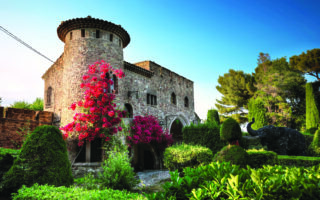Freedom of spirit
Carolyn Reynier heads for Creuse and finds that it’s easy to be captivated by the wide green spaces, tranquil countryside, cheap property and the splendid isolation
If you have been yearning for a French hideaway not just off the beaten track but in the tranquillity of rural isolation, you need look no further than the Creuse department.
Creuse lies in the north-west of the Massif Central, occupying a central position 350km south of Paris, 350km to the west of Lyon and 315km north-east of Bordeaux. Part of the Limousin region, its four main towns are Gu�ret, the chefs-lieux are La Souterraine (direct train link to Limoges for the airport or Paris), Aubusson and Bourganeuf.
This is a land of water, trees and wide open spaces; the rural department par excellence. The sparse population is spread out in villages and hamlets; from hedged bocage farmland to wooded hillsides, each patch and parcel bears traces of human activity, primarily agriculture. Thus the Creusois environment lends itself to a wide variety of outdoor activities: hiking, riding and mountain biking. Lovers of watersports and fishing are well served too by the numerous streams, rivers and manmade lakes.
RIVER OF DREAMS
The Plateau de Millevaches, part of the Parc Naturel R�gional de Millevaches, is an area of heathland and heather with the River Thaurion winding its way through the middle. It straddles the three Limousin departments – the other two being Corr�ze and Haute-Vienne – and is a middle mountain zone where the altitude varies between 500m and 980m.
The springs of Millevaches – the name is said to come from a local word vacca, meaning spring – feed the numerous streams and rivers of the Loire and Dordogne basins, the V�z�re and the Vienne being the most well known.
At the heart of this vast territory lies the Lac de Vassivi�re, created in 1951 from the construction of the Dam de la Maulde, 220m long and 30m high. This artificial lake, covering 1,000ha and surrounded by 45km of banks, is an important tourist attraction, offering various nautical activities, the Centre International d’Art et du Paysage on Vassivi�re island, fishing, walks, cyclotourisme plus a holiday village.
I first discovered Creuse when my husband and I stayed there in a small isolated hotel while researching the viability of buying something in, or near, Aubusson or Gu�ret. We didn’t pursue that particular plan but I do recall that it was here that I first tasted Suze, a deep yellow, slightly bitter gentian-based ap�ritif in a tall brown bottle. Cellar stocks were low (it was very out of season) and this was one of the few drinks stocked behind the hotel bar during our four-day stay. Neat over ice, it was delicious.
If you are interested in buying or starting up an accommodation-based business here, the Conseil G�n�ral is keen to help, with technical advice from the departmental tourism committee. Be it rural g�tes, B&B, campsites or hotels, grants are available to help owners offer a quality product.
The Pays de Gu�ret is home to 37,500 inhabitants: 30% of the Creusois population, who live in 44 communes. At the edge of the Chabri�res forest, the town itself (population 15,000) lies at the centre of the Monts de Gu�ret between the rivers Creuse and Gartempe. Among the various collections at the Mus�e d’Art et d’Arch�ologie, created in 1832, you can see Celtic and Gallo-Roman artefacts excavated during local digs as well as works dedicated to artists who have painted the Creuse valley.
GOOD CONNECTIONS
Creusois born and bred, Sebastien Naillat opened La Fontaine Immobilier in Gu�ret 10 years ago. He covers the entire department and reports that prices, which had fallen since 2009, and in some cases continue to do so, are, on balance, now stable. Although he still sees some foreign buyers today, they are in the minority; most of his clients are either from the Creuse itself or adjoining departments. Quite a sizeable British population had established itself in the department and, thanks to flights into Limoges airport, he still sees new UK arrivals but they are far fewer today.
“They tend to head for the southern Creuse,” says Naillat. “Places like Pontarion, south of Gu�ret, and B�nevent are popular, because they are nearer to Limoges and the airport.”
The average budget for investment in property is between €80,000 and €135,000, he says. In the centre of Gu�ret you will find old stone terraced houses perhaps with a small courtyard or garden for €120,000 to €130,000. For the investor, there is good annual rental potential in the larger market towns, which have schools and all the usual amenities.
Land is available and cheap. Within a 10km radius of the town, you will pay on average €30-€35 per square metre, falling to €10-€15 per square metre as you move out into the countryside and away from shops and services.
There is no shortage of old tumbledown cottages and barns for renovation, either. Traditional old Creusois houses are built from granite, with small windows and very old, small tiles on the roofs, known locally as la petite tuile. Cottages with thatched roofs can still be found but they are rare. There are two dominant colours of granite in the area depending on which quarry the stone came from: one is called blue granite, the other rather more beige in tone. You do occasionally find granite with a pink vein in it but it is rare.
OUT OF THE PLACES
In Naillat’s experience, British buyers often start on the property ladder here by buying a pied-�-terre to see how they are going to adapt to life in Creuse. Newcomers need to adapt to the climate, to the local way of life. “We have weather conditions which can be difficult and, even in places that are served by shops, it’s still an area in which you often have to travel many kilometres to access different services,” he says. “People who live in large cities aren’t always used to doing that.” Sound advice.
For those of you who are addicted to weather forecasts, I recently had occasion to speak to weatherman Didier Roquecave at M�teo France and asked him about the Limousin climate. Lying in the centre of France as it does, the climate trends to oceanic in the west, continental in the east, with mountain conditions on the heights of the Millevaches plateau. It cannot rival the gentle climate of the Atlantic coast or the sunshine of the C�te d’Azur, he says, but neither does it have the excesses experienced elsewhere.
Autumn is la belle saison. The rain falls, of course, but Indian summers are often a reality. Winters are rarely very cold and if January 1985 remains engraved in the collective Limousin memory, with extremes below -20�C, who remembers that it was followed by a February in which one could picnic on the terrace, he muses? The rainiest season is winter but the Limousin owes its summer glories to this rain, says Roquecave. It is the source of life: green fields, welcoming forests, fish-filled rivers.
The total average annual rainfall in Limousin is in excess of 1,300 litres per square metre, presumably providing the source of a considerable amount of life. At higher altitudes (above 600m), you can expect more than 100 days of frost on average, plus snow and average temperatures of around 2�C in January.
WORLD FAMOUS
Paul Haskett moved from the UK to Creuse six years ago and today lives in a hamlet outside Bourganeuf, 30km south-west of Gu�ret. He is an independent estate agent working within the Leggett Immobilier network and mandates properties within an hour’s drive of his home. This takes in the western Creuse, north to the regional border, and east to Aubusson which is world famous for its 600-year-old history of weaving tapestries.
The property market is very stable, he confirms, adding: “It’s not a dynamic market like in the UK where you get a percentage increase each year. Prices in Creuse are some of the lowest in France.”
Most of the houses he sells are under €100,000 because that is the amount of money people can get their hands on to buy a second home. “I’ve got some wrecks for €30,000 then once you get up to €60,000-€70,000 you’re getting something a bit more habitable in which you can live,” he says.
RUIN TO RESTORE
Although the majority of clients are from the UK, he also has French buyers including Parisians. He recently sold a house in the north of the department – at €240,000 quite an expensive one by Creuse standards – to a Parisian couple for use as a holiday home.
“English people had bought it a good 14 or 15 years ago,” says Haskett. “They’d invested in it and always planned to eventually sell it for their pension plan: five or six bedrooms, easily 200m� habitable, with a swimming pool out the back.”
At the other end of the scale, Haskett has recently sold a “wreck” in B�nevent-l’Abbaye about 20 minutes south-west of Gu�ret. The small three-bedroom townhouse is currently uninhabitable and needs everything doing to it. “That’s gone for €34,000 to an American couple who live in Las Vegas.”
Too small for you? Alternatively, you could buy for renovation a group of three houses (350m� of floor space, seven bedrooms), four barns and various outbuildings – an entire village, in fact, located at the end of a lane, 5km from the main road between Gu�ret and Gouzon; no neighbours, more than six hectares of meadows and woods, and the chance to do exactly what you want because you own the lot (it is on the market for €218,000 with Agence Creusoise). n
www.la-fontaine-immobilier.com
www.leggett-immo.com
www.agencecreusoise.com
Share to: Facebook Twitter LinkedIn Email


